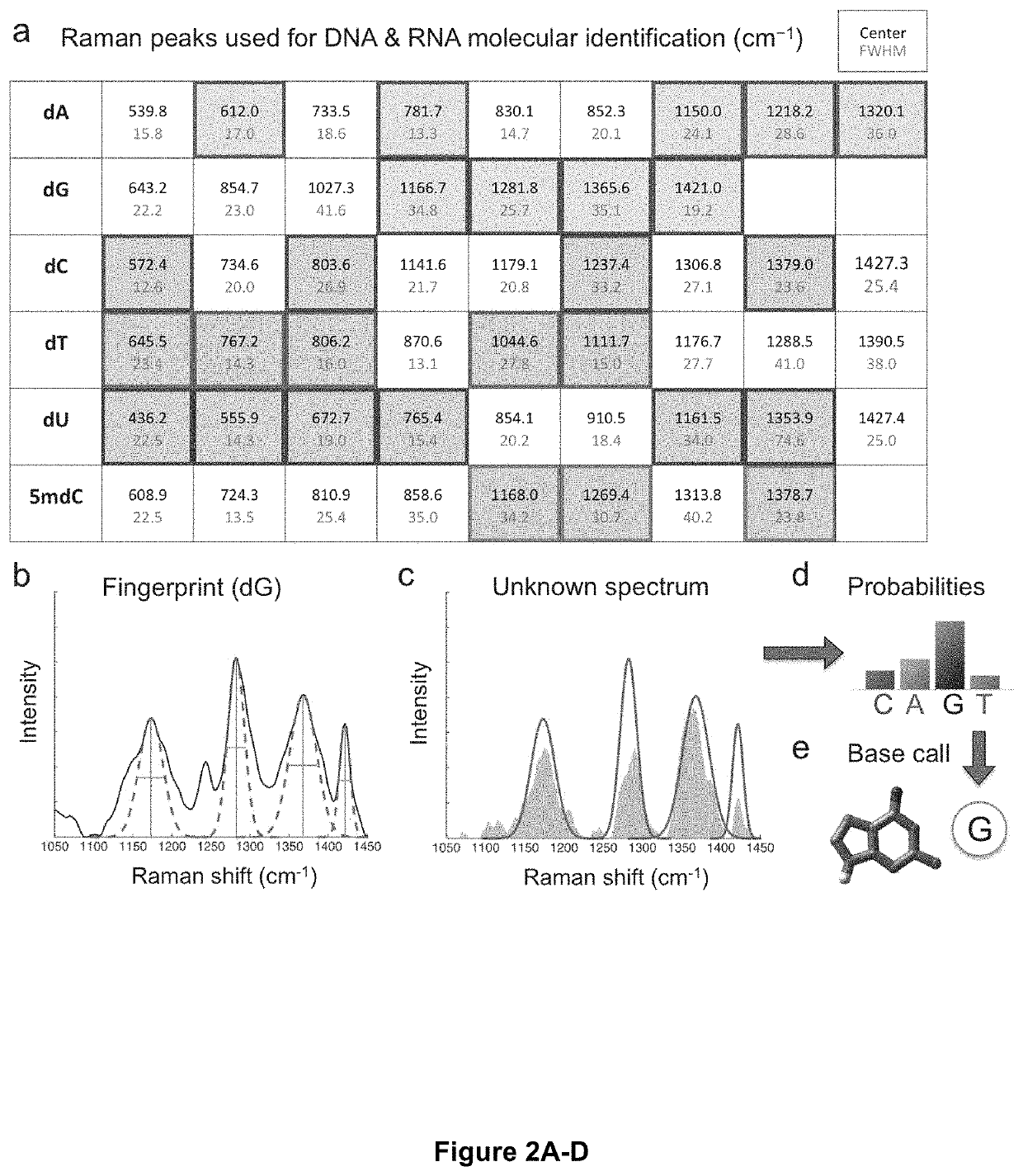Single-molecule optical sequence identification of nucleic acids and amino acids for combined single-cell omics and block optical content scoring (BOCS): DNA k-mer content and scoring for rapid genetic biomarker identification at low coverage
a single-molecule, omics technology, applied in the field of single-molecule optical sequence identification of nucleic acids and amino acids, can solve the problems of inability to accurately identify dna and rna bases, require separate and tedious bisulfite sequencing processes, and prolong the controversy, so as to achieve accurate discrimination between different nucleobases or amino acids, and high-throughput single-molecule optical reads
- Summary
- Abstract
- Description
- Claims
- Application Information
AI Technical Summary
Benefits of technology
Problems solved by technology
Method used
Image
Examples
example 1
lecule SERS Measurements on Leaning Nanopillar Substrates
[0055]Optical sequencing of amino acids and nucleotides in proteins, DNA, and RNA from individual cells requires a strong enhancement of the optical signatures in order to accurately detect and characterize the signal from single molecules. Furthermore, individual proteins or nucleic acid molecules must be spatially isolated on a substrate such that their respective signals can be resolved. To achieve reproducible and high-density SERS enhancement on an inexpensive substrate, the present inventors used ‘leaning nanopillar’ substrates that were generated by reactive ion etching of silicon wafers followed by deposition of a thin coating of silver metal. These substrates, which can be generated in wafer scale and are commercially available, trap single-molecules in nanoscale ‘hotspots’ that focus and intensify the local electromagnetic field, resulting in an easily observable optical signal enhanced by many orders of magnitude ov...
example 2
gerprinting for Nucleic Acid Identification
[0060]Next the present inventors sought to establish an optical fingerprint for each of the DNA and RNA nucleotides (adenine, A; guanine, G; cytosine, C; thymine, T; uracil, U; and 5-methylcytosine, 5 mC) using sets of specific Raman peaks, in order to perform sequence identification of unknown DNA and RNA oligomers. Previous work from our group showed that characteristic sets of peaks in Raman spectra of DNA homopolymers on silver nanopyramid arrays could be used to distinguish the different DNA bases with high accuracy. Specifically, the present inventors sought to extend this approach in order to identify DNA and RNA nucleotides and epigenetic modifications from SERS measurements on the nanopillar substrates. To this end, the present inventors first generated a spectral library by carrying out SERS measurements on dilute solutions of poly-(dN)x and poly-(rN)x homopolymers (N=A, G, C, T, 5 mC, or U), where the length of the oligomer x was...
example 3
equence Identification of DNA and RNA
[0064]Next, the present inventors sought to test the invention's optical fingerprinting and molecular identification method in the context of single-molecule sequencing. To this end, the present inventors generated random ‘unknown’ sequences of DNA or RNA bases and pulled corresponding single measurements from our spectral library for each base. The measurements were then fed into the molecular identification algorithm to predict the sequence of the unknown, which the present inventors then compared to the actual generated sequence to produce a sequencing trace plot. Representative segments of resulting trace plots for DNA and RNA sequencing are shown in FIG. 3c, d, respectively (full trace plots shown in FIG. 11). In both cases, the algorithm was able to successfully predict the bases in the unknown sequence with a high degree of accuracy, with an error rate of <3% for DNA and <5% for RNA. The trace plots also display the calculated probability ...
PUM
 Login to View More
Login to View More Abstract
Description
Claims
Application Information
 Login to View More
Login to View More - R&D
- Intellectual Property
- Life Sciences
- Materials
- Tech Scout
- Unparalleled Data Quality
- Higher Quality Content
- 60% Fewer Hallucinations
Browse by: Latest US Patents, China's latest patents, Technical Efficacy Thesaurus, Application Domain, Technology Topic, Popular Technical Reports.
© 2025 PatSnap. All rights reserved.Legal|Privacy policy|Modern Slavery Act Transparency Statement|Sitemap|About US| Contact US: help@patsnap.com



